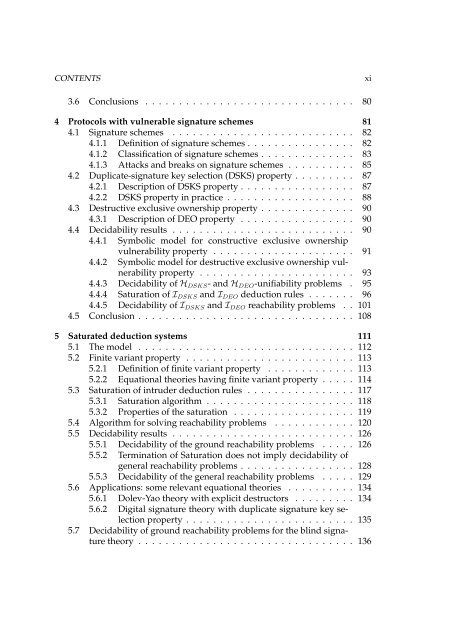Logical Analysis and Verification of Cryptographic Protocols - Loria
Logical Analysis and Verification of Cryptographic Protocols - Loria
Logical Analysis and Verification of Cryptographic Protocols - Loria
You also want an ePaper? Increase the reach of your titles
YUMPU automatically turns print PDFs into web optimized ePapers that Google loves.
CONTENTS xi<br />
3.6 Conclusions . . . . . . . . . . . . . . . . . . . . . . . . . . . . . . . 80<br />
4 <strong>Protocols</strong> with vulnerable signature schemes 81<br />
4.1 Signature schemes . . . . . . . . . . . . . . . . . . . . . . . . . . . 82<br />
4.1.1 Definition <strong>of</strong> signature schemes . . . . . . . . . . . . . . . . 82<br />
4.1.2 Classification <strong>of</strong> signature schemes . . . . . . . . . . . . . . 83<br />
4.1.3 Attacks <strong>and</strong> breaks on signature schemes . . . . . . . . . . 85<br />
4.2 Duplicate-signature key selection (DSKS) property . . . . . . . . . 87<br />
4.2.1 Description <strong>of</strong> DSKS property . . . . . . . . . . . . . . . . . 87<br />
4.2.2 DSKS property in practice . . . . . . . . . . . . . . . . . . . 88<br />
4.3 Destructive exclusive ownership property . . . . . . . . . . . . . . 90<br />
4.3.1 Description <strong>of</strong> DEO property . . . . . . . . . . . . . . . . . 90<br />
4.4 Decidability results . . . . . . . . . . . . . . . . . . . . . . . . . . . 90<br />
4.4.1 Symbolic model for constructive exclusive ownership<br />
vulnerability property . . . . . . . . . . . . . . . . . . . . . 91<br />
4.4.2 Symbolic model for destructive exclusive ownership vulnerability<br />
property . . . . . . . . . . . . . . . . . . . . . . . 93<br />
4.4.3 Decidability <strong>of</strong> HDSKS- <strong>and</strong> HDEO-unifiability problems . 95<br />
4.4.4 Saturation <strong>of</strong> IDSKS <strong>and</strong> IDEO deduction rules . . . . . . . 96<br />
4.4.5 Decidability <strong>of</strong> IDSKS <strong>and</strong> IDEO reachability problems . . 101<br />
4.5 Conclusion . . . . . . . . . . . . . . . . . . . . . . . . . . . . . . . . 108<br />
5 Saturated deduction systems 111<br />
5.1 The model . . . . . . . . . . . . . . . . . . . . . . . . . . . . . . . . 112<br />
5.2 Finite variant property . . . . . . . . . . . . . . . . . . . . . . . . . 113<br />
5.2.1 Definition <strong>of</strong> finite variant property . . . . . . . . . . . . . 113<br />
5.2.2 Equational theories having finite variant property . . . . . 114<br />
5.3 Saturation <strong>of</strong> intruder deduction rules . . . . . . . . . . . . . . . . 117<br />
5.3.1 Saturation algorithm . . . . . . . . . . . . . . . . . . . . . . 118<br />
5.3.2 Properties <strong>of</strong> the saturation . . . . . . . . . . . . . . . . . . 119<br />
5.4 Algorithm for solving reachability problems . . . . . . . . . . . . 120<br />
5.5 Decidability results . . . . . . . . . . . . . . . . . . . . . . . . . . . 126<br />
5.5.1 Decidability <strong>of</strong> the ground reachability problems . . . . . 126<br />
5.5.2 Termination <strong>of</strong> Saturation does not imply decidability <strong>of</strong><br />
general reachability problems . . . . . . . . . . . . . . . . . 128<br />
5.5.3 Decidability <strong>of</strong> the general reachability problems . . . . . 129<br />
5.6 Applications: some relevant equational theories . . . . . . . . . . 134<br />
5.6.1 Dolev-Yao theory with explicit destructors . . . . . . . . . 134<br />
5.6.2 Digital signature theory with duplicate signature key selection<br />
property . . . . . . . . . . . . . . . . . . . . . . . . . 135<br />
5.7 Decidability <strong>of</strong> ground reachability problems for the blind signature<br />
theory . . . . . . . . . . . . . . . . . . . . . . . . . . . . . . . . 136
















